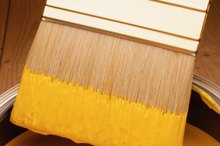How to Paint Asbestos Siding
Asbestos siding is a cement-based siding that contains asbestos. It was popular in the 1960s and 1970s across the nation and is still on homes constructed during that period. Since it doesn’t expand or contract with the outside temperature, asbestos siding makes a good base for paint. With a little preparation and the right tools, you’ll have a nice new coat of paint on your home.
Remove any peeling paint. Often, since asbestos siding holds paint so well, there won’t be any but if there is it you must remove it before you can repaint. Since asbestos is only dangerous when it is in a friable state, you will remove the paint without sanding or scraping. Use a water blaster for the large pieces and allow the siding to dry thoroughly.
Signs & Symptoms of a Damaged Furnace Heat Exchanger
Learn More
Apply a liquid sander solution by rolling on liberally with a paint roller and using clean rags to rub and smooth the surface. In addition to removing small loose pieces of old paint, the solution softens the edges of firmly attached paint to reduce a mottled surface after painting. Even if there is no peeling paint, you must take this step to prepare the surface to hold paint.
Fix any loose siding shingles and replace broken ones, if needed. A non-asbestos replacement shingle is available from do-it-yourself centers. After painting, no one will know the difference.
How to Clean High School Jacket Vinyl Sleeves
Learn More
Apply a coat of primer to the newly cleaned siding. The primer creates an adhesive surface for the paint and helps seal the color of the old paint. You can roll it or brush it on but make sure you get under the small lip at the bottom of each asbestos siding shingle. Allow the primer to dry completely.
Begin painting the siding with your choice of brushes and rollers, making sure to check often for runs. One concern when repainting this type of siding is the small gaps between the shingles. These are traps for wet paint so as you continue to work, pause every few minutes and go back to the area you just painted, looking for runs. Correct them by using a brush and lightly brushing out the run while it is wet.
Cut in paint along windows, doors and eaves with a good brush that disperses paint smoothly.
Repeat the painting process until you have two complete coats of oil-based paint on the siding.
Warnings
Do not sand or saw the asbestos shingles to prevent particles from entering the air you breathe. Wear safety goggles if you are using a water blaster.
Related Articles
Writer Bio
Glenda Taylor is a contractor and a full-time writer specializing in construction writing. She also enjoys writing business and finance, food and drink and pet-related articles. Her education includes marketing and a bachelor's degree in journalism from the University of Kansas.









